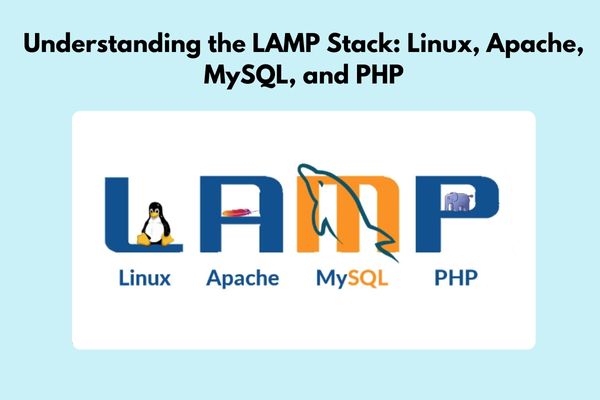Understanding the LAMP Stack: Linux, Apache, MySQL, and PHP
 Brijesh Prajapati
Brijesh Prajapati
The LAMP stack is one of the most widely used technology stacks in web development, powering millions of websites and applications. It stands for Linux, Apache, MySQL, and PHP, which together create a powerful environment for building dynamic websites. This stack is popular because of its open-source nature, reliability, and ease of use.
In this article, we’ll explore each component of the LAMP stack and understand how they work together to create a fully functional web development platform.
What is the LAMP Stack?
The LAMP stack is a combination of technologies commonly used to host and serve websites and web applications. Each letter in LAMP represents one of the core components:
Linux: The operating system
Apache: The web server
MySQL: The database management system
PHP: The programming language
These components together provide a complete framework for developers to build, deploy, and manage web applications. Because all components are open-source, developers worldwide prefer using the LAMP stack as it offers both cost efficiency and flexibility.
Why Use the LAMP Stack?
The LAMP stack stands out due to its flexibility, scalability, and cost-efficiency. Let’s explore why:
Open Source: All components of the LAMP stack are free to use, distribute, and modify, making it highly cost-effective.
Cross-Platform: Although it works on various operating systems, Linux is the most common platform for the LAMP stack, making it versatile for hosting environments.
Community Support: The widespread use of LAMP has led to a vast community that provides extensive support and resources.
Stability and Security: Linux, Apache, MySQL, and PHP have consistently proven to be stable and secure, offering a reliable environment for development.
Components of the LAMP Stack
Let’s take a closer look at each part of the LAMP stack and see how they contribute to creating a seamless web application.
1. Linux: The Foundation
Linux serves as the foundation for the LAMP stack. It’s the operating system that hosts the other components, creating a stable and flexible environment for development. While the LAMP stack can function with other operating systems, such as Windows or macOS, Linux is the preferred choice because of its open-source nature and wide acceptance.
Key Features of Linux:
Stability: Linux is known for its robust stability, providing minimal downtime.
Security: Linux’s architecture is highly secure, making it ideal for web applications.
Customization: Developers can modify and configure Linux according to their project’s specific requirements.
Most web servers on the internet use Linux, making it the default choice for hosting web applications in the LAMP stack.
2. Apache: The Web Server
Apache is the web server that handles requests from users’ browsers and serves web pages. When a user requests a web page, Apache listens to that request, processes it, and returns the appropriate content, such as HTML pages or other resources.
Key Features of Apache:
Highly Configurable: Apache offers flexibility in its configuration, allowing developers to adapt it to various needs.
Modular Structure: Apache’s modular architecture enables adding or removing functionalities as required, making it scalable.
Cross-Platform: While it is frequently used with Linux, Apache can also run on various other operating systems.
3. MySQL: The Database
MySQL is the database management system (DBMS) used in the LAMP stack. It manages and stores data for web applications. MySQL uses a relational model, allowing developers to organize data into tables and perform complex queries using SQL (Structured Query Language).
Key Features of MySQL:
Relational Database: MySQL organizes data into related tables, ensuring data integrity and ease of management.
Scalability: MySQL can handle large amounts of data and simultaneous users, making it suitable for both small and large applications.
Security: MySQL includes built-in security features, such as user authentication and data encryption, ensuring data protection.
For example, web applications often use MySQL to store user information, product details, or transaction records.
4. PHP: The Programming Language
PHP is the scripting language in the LAMP stack that builds dynamic web pages. It works with Apache to process requests and generate HTML content to send back to the user. PHP’s ability to interact with databases like MySQL makes it ideal for creating data-driven web applications.
Key Features of PHP:
Server-Side Scripting: PHP runs on the server and generates dynamic content based on user input and database queries.
Ease of Use: PHP is easy to learn and use, which makes it a popular choice among developers.
Integration with MySQL: PHP’s seamless integration with MySQL allows the creation of dynamic, database-driven applications.
For example, PHP is often used to build login systems, shopping carts, and content management systems.
How the LAMP Stack Works Together
Each component of the LAMP stack plays a vital role in the development process, and they work together seamlessly. Here’s how these technologies interact to serve web content:
User Request: A user requests a web page by typing a URL into their browser.
Apache: The Apache web server receives the request and passes it to the PHP script if needed.
PHP: The PHP script processes the request, possibly interacting with the MySQL database to fetch or modify data.
MySQL: If necessary, MySQL processes the query and returns the data to PHP.
Response: PHP uses the retrieved data to generate an HTML response, which Apache then sends back to the user’s browser.
This entire process happens in real-time, allowing users to interact with the website efficiently.
Benefits of the LAMP Stack
Cost Efficiency
The LAMP stack offers a cost-effective solution for web development since all components are open-source, eliminating licensing fees. This makes it a suitable choice for startups, small businesses, and even large enterprises.
Flexibility and Customization
LAMP allows for complete customization, giving developers control over the operating system, web server, database, and programming environment. This flexibility enables developers to tailor each layer of the stack to meet specific project needs.
Strong Security
Each component in the LAMP stack provides robust security features. Linux’s secure architecture, MySQL’s data encryption, and Apache’s access controls all contribute to a secure web development environment.
Conclusion
The LAMP stack remains one of the most popular choices for web development due to its simplicity, flexibility, and open-source nature. With Linux providing the foundation, Apache managing requests, MySQL handling data, and PHP generating dynamic content, developers have a powerful toolset at their disposal.
For anyone starting in web development, mastering the LAMP stack can open up countless opportunities. Educational resources, such as the Full Stack Development Course in Bhopal and all cities in India, can guide developers in learning and applying the LAMP stack to build dynamic, data-driven web applications.
Understanding the LAMP stack equips developers with the knowledge and skills needed to build everything from simple websites to complex, scalable web applications.
Subscribe to my newsletter
Read articles from Brijesh Prajapati directly inside your inbox. Subscribe to the newsletter, and don't miss out.
Written by

Brijesh Prajapati
Brijesh Prajapati
I'm a digital marketer eager to expand my skills and knowledge. Passionate about staying updated with the latest trends, I thrive on learning new techniques and strategies to enhance my expertise.